This post may contain affiliate links, meaning I may earn a commission if you make a purchase, at no extra cost to you. I only recommend products I trust. Thank you for your support.
Table of Contents
Mounjaro is a branded form of tirzepatide, a dual GLP-1/GIP hormone agonist used to treat type 2 diabetes.
In plain terms, it mimics gut hormones (GLP-1 and GIP) to help your body release insulin, reduce liver glucose output, slow stomach emptying, and curb appetite.
This combination of effects means Mounjaro is very effective for lowering blood sugar in type 2 diabetes and promoting weight loss.
In fact, clinical trials showed patients lost about 20% of body weight on tirzepatide (Mounjaro) versus 13.7% on semaglutide.
In recent years, many people have discovered that Mounjaro also causes significant weight loss when combined with a healthy lifestyle and a Mounjaro diet.
Mounjaro (tirzepatide) is FDA-approved for adults with type 2 diabetes, and it is also used off-label or in special cases for weight loss management.
Because Mounjaro both lowers blood sugar and suppresses appetite, following a healthy Mounjaro diet plan is important to maximize its benefits.
What is a Mounjaro Diet?
A Mounjaro diet or tirzepatide diet refers to a style of eating designed to support people who are taking Mounjaro (tirzepatide), a prescription medication used to help manage type 2 diabetes and support weight loss.
Since Mounjaro works by improving insulin sensitivity, regulating blood sugar, and reducing appetite, the diet that pairs best with it usually focuses on low carb high protein meals and nutrient-dense foods.
The goal of a Mounjaro diet is to:
- Stabilize blood sugar by limiting simple carbs and sugary foods.
- Support weight loss with lean proteins, fiber-rich vegetables, and healthy fats.
- Boost energy levels while avoiding spikes and crashes.
- Prevent nausea and digestive issues (a common side effect of Mounjaro) by emphasizing smaller, balanced meals.
In short, the Mounjaro diet isn’t a strict “one-size-fits-all” program, but rather a meal plan for Mounjaro users that makes the medication work more effectively by pairing it with smart food choices.
Why this Mounjaro Diet Plan Matters
You might be asking yourself, “Do I really need a special diet while taking Mounjaro?” The truth is, you don’t have to follow a strict or rigid Mounjaro diet plan.
However, choosing a smart, balanced way of eating can make a big difference and help you get the best results from the medication.
Mounjaro works by reducing appetite, but if you fill up on low-nutrient foods, you could miss out on key vitamins and protein needed to stay healthy.
Experts agree that the best way to support Mounjaro is with a balanced Mounjaro diet plan that focuses on whole foods.
That means focusing on real foods, like fresh vegetables, lean proteins, and whole grains, rather than processed or sugary options.
The medication works hand in hand with healthy lifestyle changes to help lower blood sugar and promote weight loss.
When Mounjaro slows stomach emptying and makes you feel full sooner, eating a high protein meal helps preserve muscle mass even as you lose fat.
Aim for at least the recommended 50 to 60 grams of protein daily (many experts suggest even more on GLP-1 therapies).
Protein and fiber also mitigate hunger: you can pile vegetables (fiber) and lean meats (protein) on your plate without consuming too many calories.
Additionally, eating smaller, balanced meals more frequently can reduce side effects like nausea, which is common in the first weeks of Mounjaro.
7-Day Mounjaro Meal Plan (Easy Mounjaro Recipes)
This easy Mounjaro meal plan is designed to provide about 1200 to 1500 calories per day, making it suitable for weight loss while still giving your body the nutrients it needs.
Each day includes low carb high protein meals paired with easy Mounjaro recipes that keep blood sugar steady and hunger under control.
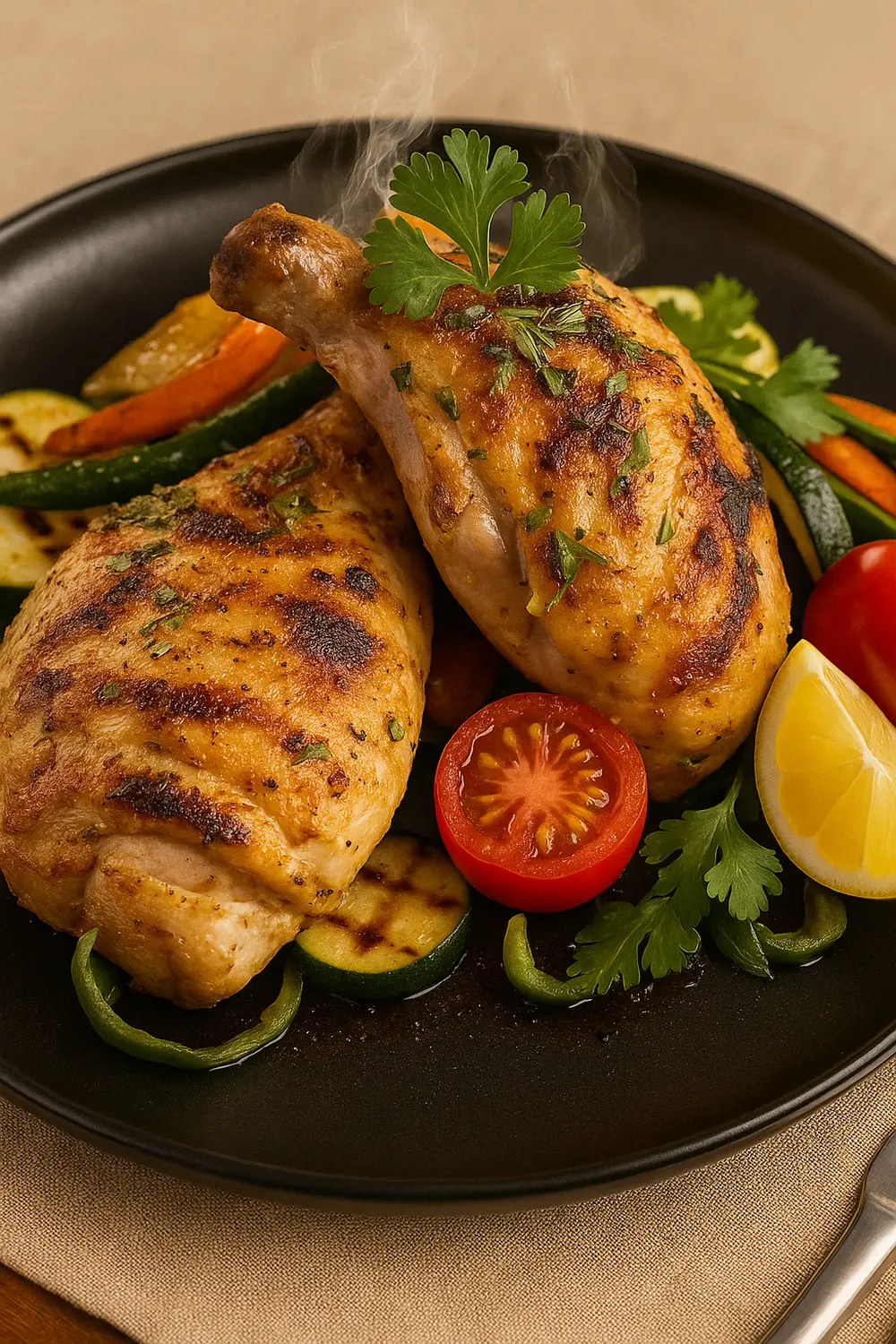
Day 1
Breakfast:
- Mushroom Omelette: A fluffy, golden omelette filled with tender sautéed mushrooms, onions, and fresh herbs for a protein-rich breakfast that is low in carbs.
Lunch:
- Greek Cucumber Tomato Salad: A refreshing Mediterranean salad made with crisp cucumber slices, juicy cherry tomatoes, red onion, and Kalamata olives, tossed with crumbled feta cheese and a drizzle of olive oil and red wine vinegar.
Dinner:
- Grilled Chicken with Roasted Vegetables: Lean chicken breast marinated in garlic, lemon, and olive oil, then grilled until juicy and smoky, served with a medley of oven-roasted zucchini, bell peppers, and carrots tossed in herbs.
Snacks:
- Cherry Tomatoes with Mozzarella: Juicy cherry tomatoes paired with mozzarella balls for a caprese-style snack.
- Nutty Trail Mix: A crunchy mix of nuts, seeds, and dried fruit for quick, energy-dense fuel.
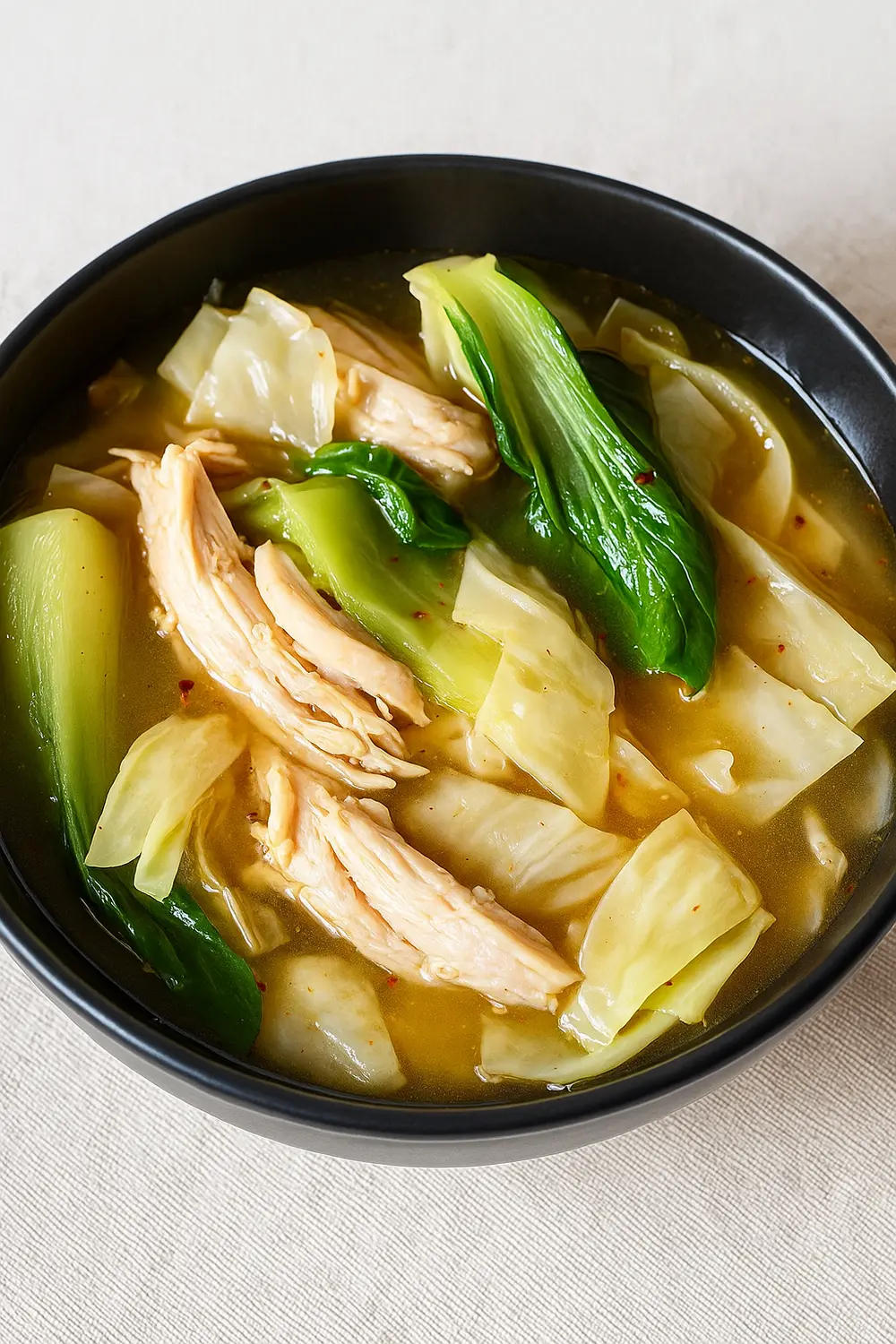
Day 2
Breakfast:
- Keto Breakfast Egg Muffins: Mini egg cups baked with spinach, cheddar cheese, and turkey sausage crumbles, portable, savory, and perfect for a high-protein breakfast on the go.
Lunch:
- Cucumber Salad with Avocado: Fresh cucumber paired with creamy avocado cubes, lightly dressed with lemon juice, olive oil, and sea salt for a hydrating, healthy fat-rich snack.
Dinner:
- Chicken and Cabbage Soup: A light broth-based soup featuring tender shredded chicken, cabbage, carrots, and onions, simmered with herbs and spices for a comforting, low carb high protein dinner.
Snacks:
- Red Bell Pepper with Guacamole: Crunchy red bell pepper strips dipped in creamy guacamole for a vitamin-rich bite.
- Kale Chips: Baked kale leaves seasoned with olive oil and sea salt for a light, crispy snack.
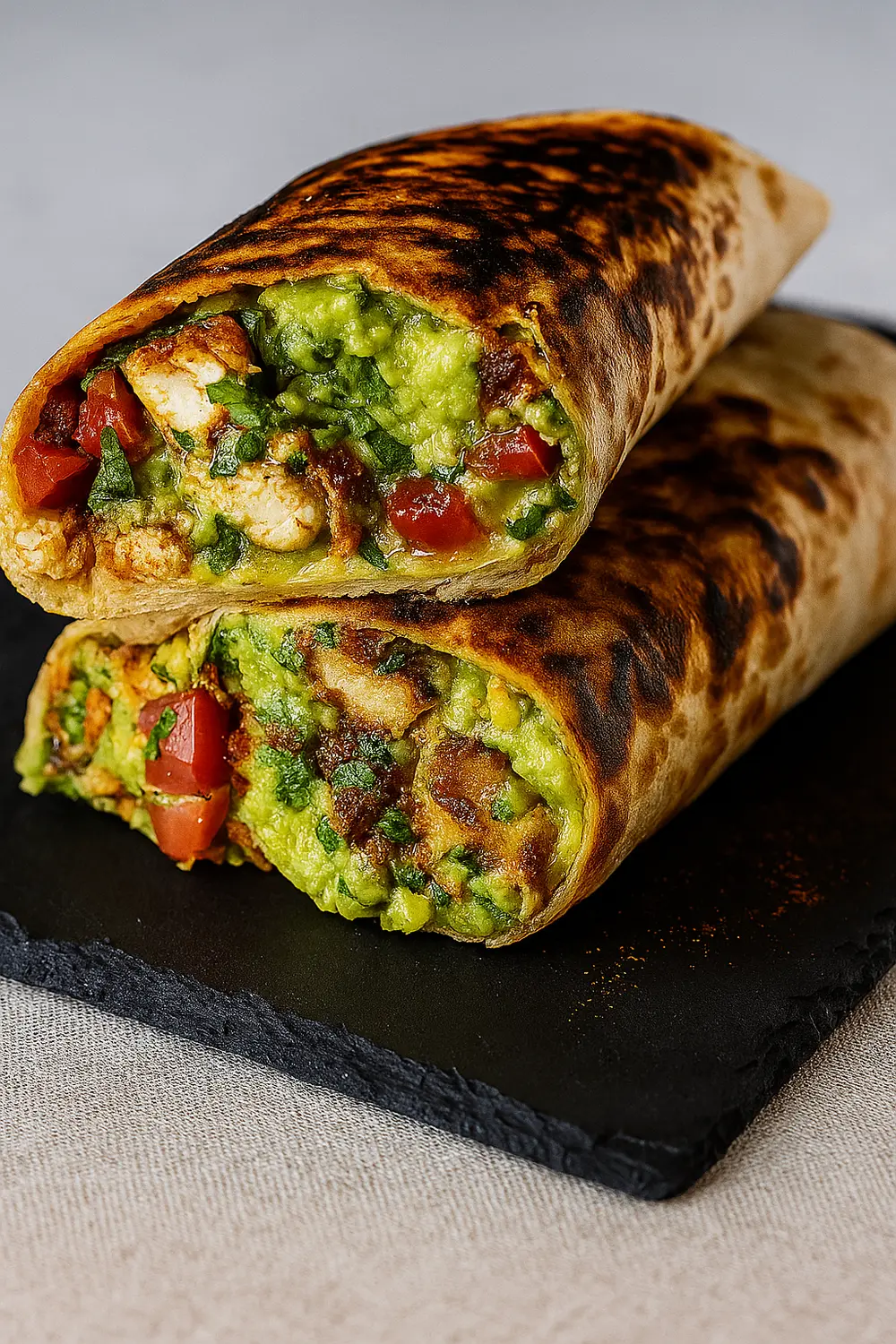
Day 3
Breakfast:
- Brazilian Mounjaro Drink: A refreshing blend of sparkling water, fresh lime juice, and mint leaves, designed to hydrate and support metabolism with a light citrus kick.
Lunch:
- Grilled Turkey and Avocado Wrap: Slices of grilled turkey breast layered with creamy avocado, crisp lettuce, and tomato, wrapped in a whole-grain tortilla for a high protein lunch.
Dinner:
- Beef Bok Choy Stir Fry: Thin slices of beef quickly stir-fried with fresh bok choy, garlic, and ginger in a savory soy-based sauce, served with brown rice, for a high fiber high protein dinner.
Snacks:
- Baby Carrots & Guacamole: Sweet baby carrots dipped in creamy avocado guacamole for a colorful, nutrient-rich snack.
- Roasted Chickpeas: Crispy, oven-roasted chickpeas seasoned with olive oil and spices for a high-fiber crunch.
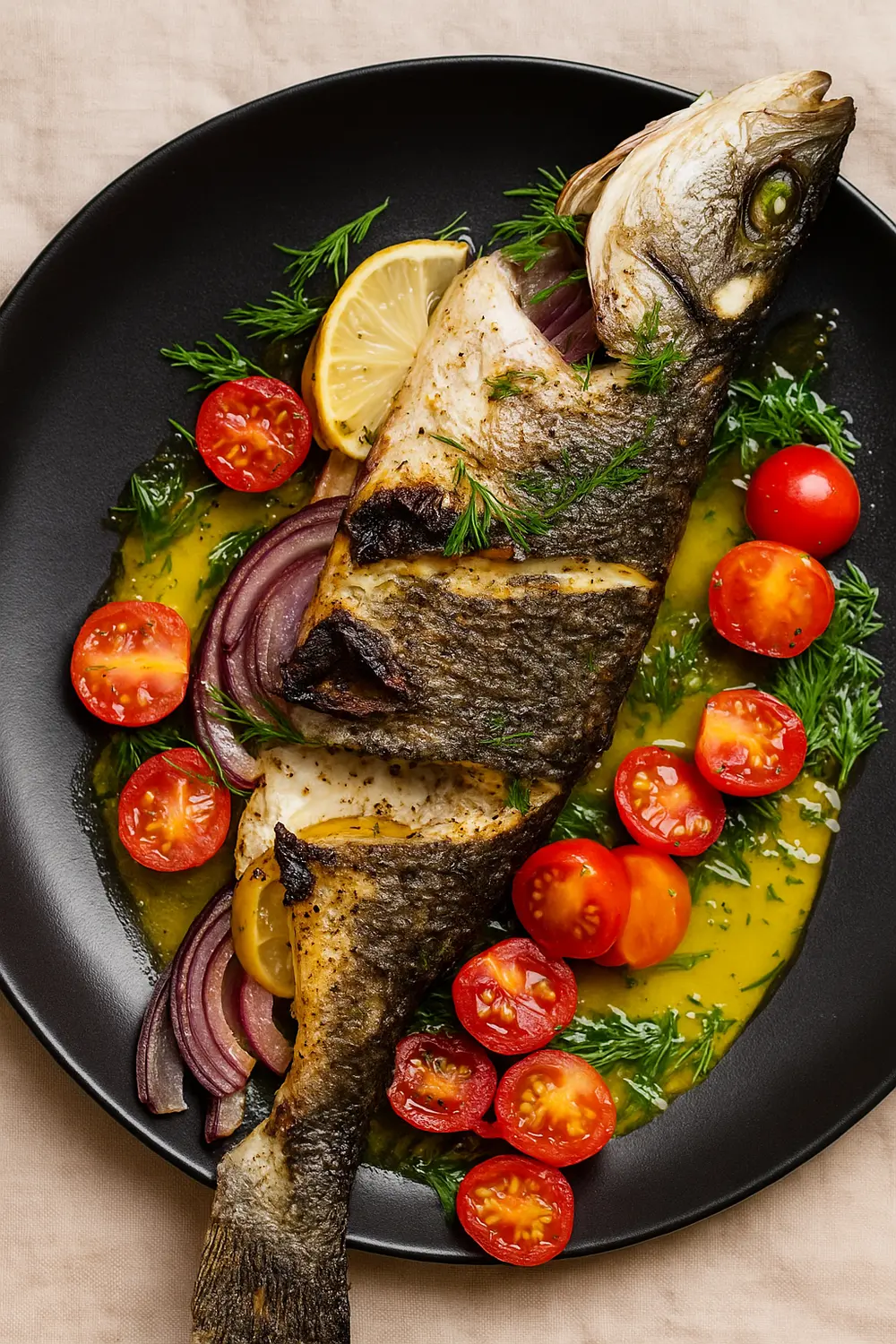
Day 4
Breakfast:
- Keto Breakfast Burrito: A low-carb tortilla filled with scrambled eggs, shredded cheese, avocado, and turkey bacon, then lightly toasted for a hearty, easy low carb breakfast.
Lunch:
- Mediterranean Branzino with Ladolemono Sauce: Whole branzino grilled to perfection and served with a zesty ladolemono sauce made from lemon, olive oil, and oregano, served with roasted asparagus for a clean, omega-rich dish.
Dinner:
- Chicken Shawarma Bowl: Spiced grilled chicken served over cauliflower rice with crisp cucumber, tomato, and a drizzle of tahini yogurt sauce, bringing Middle Eastern flavors in a balanced bowl.
Snacks:
- Hard-Boiled Egg: A firm, protein-packed boiled egg lightly seasoned with salt and pepper.
- Apple & Cheese: Crisp apple slices paired with low-fat cheese for a sweet and savory snack.
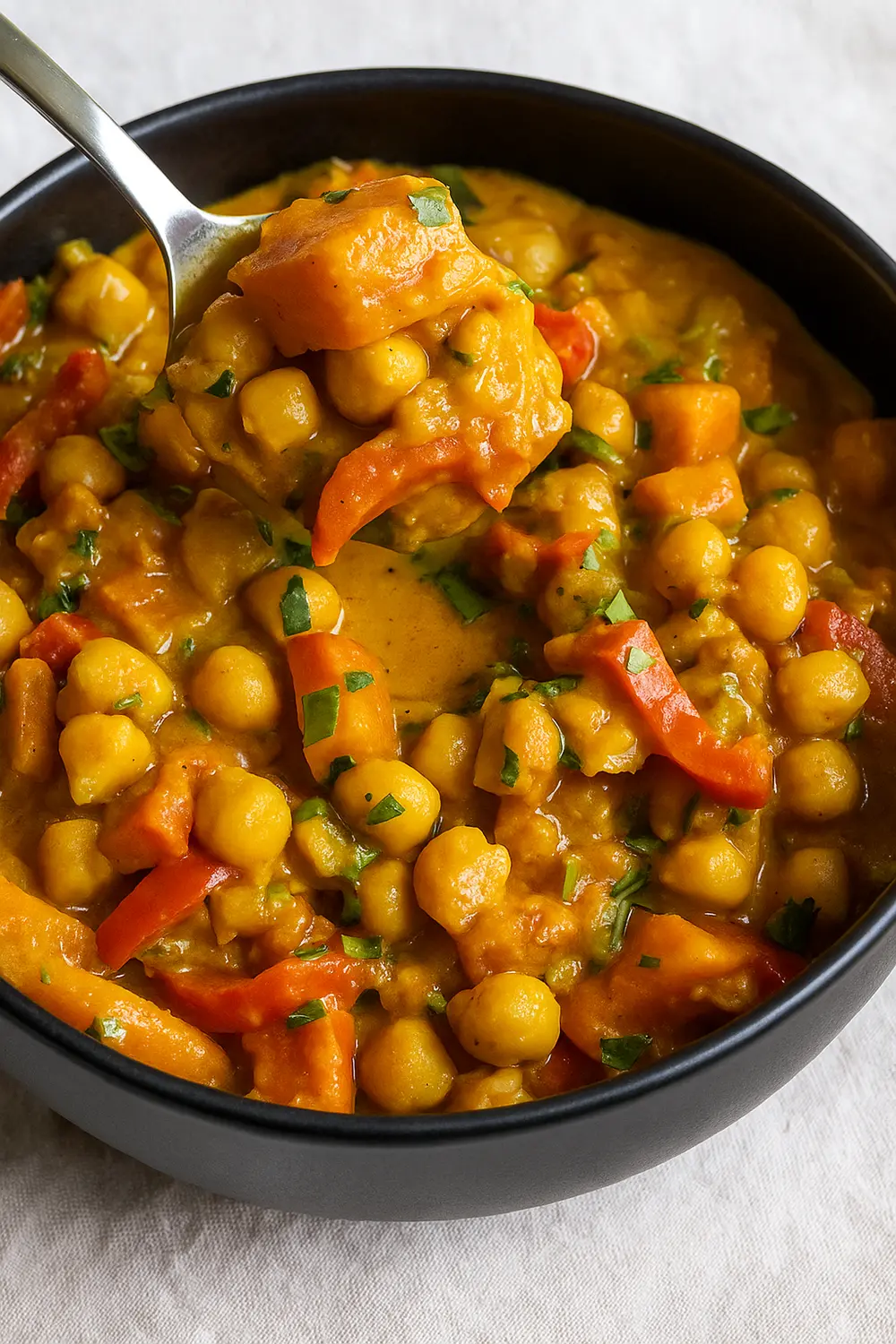
Day 5
Breakfast:
- Spinach Feta Egg White Omelette: Egg whites whipped into a fluffy omelette with sautéed spinach, tomatoes, and a sprinkle of feta cheese, served with a side of sliced avocado.
Lunch:
- Air Fryer Parmesan Shrimp: Shrimp coated in parmesan cheese, garlic, and herbs, then crisped in the air fryer for a crunchy, low carb high protein lunch.
Dinner:
- Chickpea Sweet Potato Curry: Chickpeas and tender sweet potato chunks simmered in a coconut curry sauce spiced with turmeric, cumin, and ginger for a warming, plant-based comfort meal.
Snacks:
- Berry Yogurt Bowl: Fresh berries layered over Greek yogurt with a sprinkle of chia seeds for added fiber and omega-3s.
- Mixed Nuts: A simple, crunchy blend of almonds, walnuts, and cashews for protein and healthy fats.
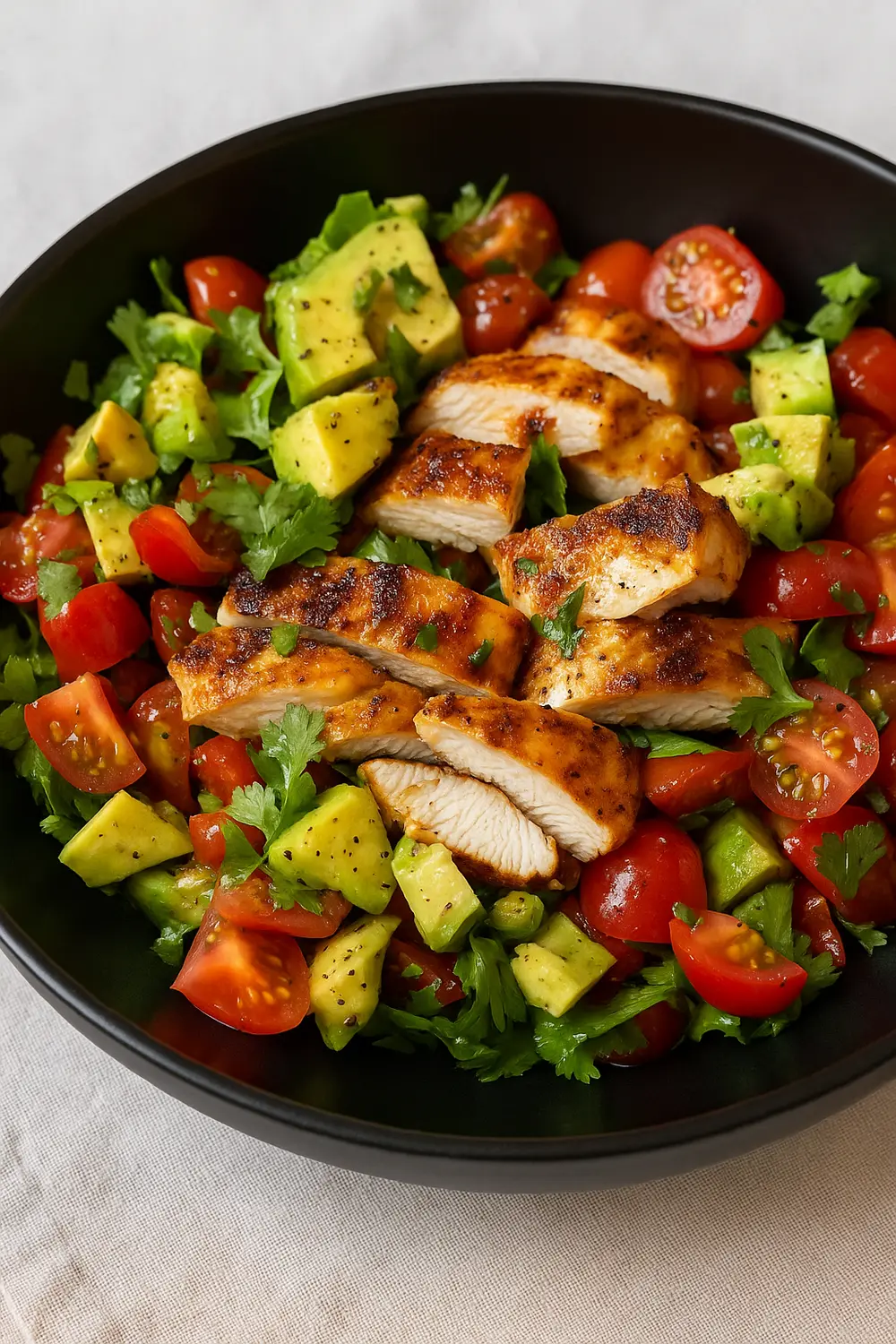
Day 6
Breakfast:
- Berry Protein Smoothie: Blend 1 scoop protein powder, unsweetened almond milk, a handful of spinach, frozen mixed berries, and a dash of flaxseeds.
Lunch:
- Asian Cucumber Salad (Oi Muchim): Crisp cucumber slices tossed in sesame oil, garlic, rice vinegar, and chili flakes for a refreshing, tangy, and slightly spicy Korean-inspired salad dish.
Dinner:
- Grilled Chicken Salad with Avocado: This salad features juicy sliced grilled chicken breast, ripe avocado chunks, halved cherry tomatoes, and fresh cilantro, all tossed together.
Snacks:
- Roasted Pumpkin Seeds: Lightly salted pumpkin seeds roasted until crunchy, rich in protein and minerals.
- Cucumber & Dip: Crisp cucumber slices served with a light yogurt or hummus dip for a refreshing and low-calorie snack.
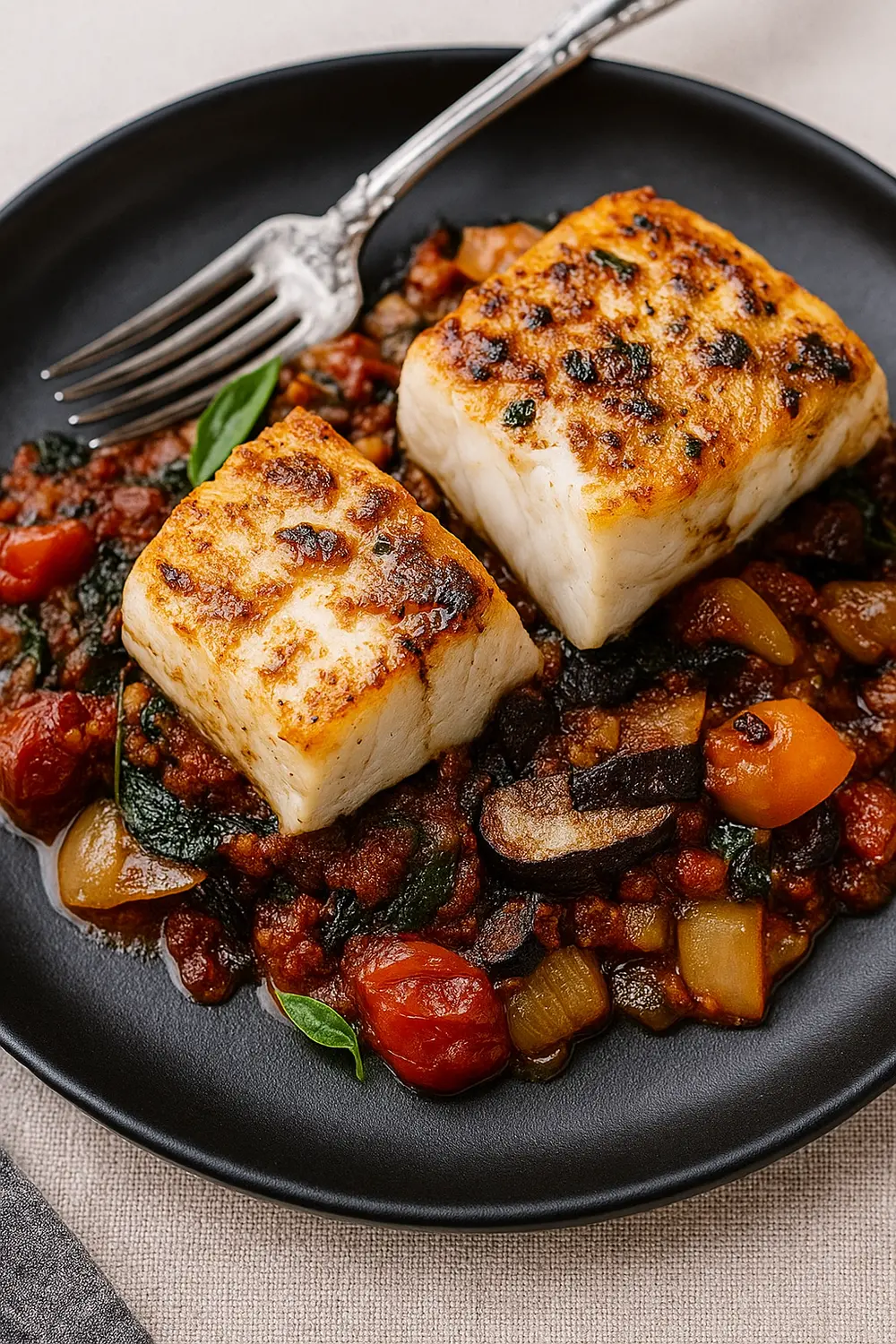
Day 7
Breakfast:
- Salmon Cakes: Baked salmon cakes (salmon mixed with egg, herbs, and a little breadcrumbs) served with mixed greens salad and lemon dill dressing.
Lunch:
- Moroccan Chicken Tagine: Chicken thighs slowly braised with Moroccan spices, cinnamon, cumin, and paprika, combined with onions, tomatoes, and olives, served with brown rice.
Dinner:
- Baked Mediterranean Cod: White cod fillet baked with olive oil, garlic, and cherry tomatoes, then garnished with fresh herbs and served with roasted vegetables for a light, lean protein dish, perfect for those on a Mounjaro diet.
Snacks:
- Low-Fat Cheese & Pear: Creamy low-fat cheese paired with sweet, juicy pear slices for a balanced mix of protein and natural sweetness.
- Yogurt Protein Bites: Frozen Greek yogurt bites blended with protein powder and fruit for a creamy, high-protein snack.
What to Eat on Mounjaro
Focus each meal on whole, nutrient-rich foods. Here are examples of foods to eat on Mounjaro:
- Vegetables: Think salads with lettuce, spinach, cucumbers, peppers, and tomatoes; steamed broccoli or green beans; roasted Brussels sprouts; grilled asparagus; or stir-fried zucchini.
- Lean Proteins: Skinless chicken or turkey, fish (salmon, cod, tuna), shrimp, eggs or egg whites, low-fat Greek yogurt, cottage cheese, tofu and tempeh, and even lean cuts of beef or pork in moderation.
- Legumes and Beans: Lentils, black beans, chickpeas, and edamame are great plant-based proteins with fiber. Add them to salads or use them in soup. They also help control blood sugar.
- Fruits (whole): Fresh berries, apples, oranges, pears. These are high in fiber and water. Limit high-sugar fruits (like pineapple or mango) if your goal is strict blood sugar control, but small portions of most fruits are fine.
- Whole Grains: Oatmeal, brown rice, quinoa, barley, whole-wheat pasta or bread (in small amounts). These sustain energy without the crash of refined carbs.
- Healthy Fats: Small portions of avocado, nuts (almonds, walnuts), seeds (chia, flax, pumpkin), olives, and olive or avocado oil. For example, sprinkle 1 to 2 tbsp of seeds or nuts on a salad, or use olive oil in cooking.
- Fermented Foods: Greek yogurt, kefir, sauerkraut, kimchi, or kombucha can support gut health. Non-fat Greek yogurt is especially good – it’s high in protein and can be paired with berries for a snack or breakfast.
- Low-Sugar Snacks: Hard-boiled eggs, low-fat cottage cheese with cucumber, raw veggie sticks with hummus, or a small apple with a slice of low-fat cheese.
Foods to Avoid on Mounjaro
To keep blood sugar steady and avoid empty calories, limit or avoid these foods while on the Mounjaro diet:
- Added Sugars and Desserts: Candy, cookies, cakes, pastries, sugary drinks (soda, sweetened juice or tea). These spike blood sugar and offer little nutrition.
- Refined Carbohydrates: White bread, white pasta, white rice, chips, and most snack foods. They lack fiber and can cause blood sugar swings.
- Sugary Beverages and Fruit Juices: Stick to water, herbal tea, or black coffee. Liquid sugars hit your blood sugar fast and don’t fill you up.
- High-Fat, Fried Foods: Fried chicken, French fries, onion rings, doughnuts, pastries, these are high in unhealthy fats and calories. Many people on Mounjaro find that greasy or spicy foods can trigger nausea.
- Saturated Fats and Processed Meats: Fatty cuts of beef/pork, bacon, sausage, hot dogs, butter, and full-fat dairy. These raise LDL cholesterol and offer few nutrients.
- Ultra-Processed Foods: Packaged frozen meals, instant noodles, sweetened cereals, and most fast food. These often contain added sugars, excess salt, and unhealthy fats that can derail weight loss.
- High-Sodium Snack Foods: Chips, crackers, cured meats, and salty restaurant fare. Excess salt can cause water retention and spikes in blood pressure.
- Artificial Sweeteners: Some evidence suggests diet sodas and artificially sweetened foods may actually trigger weight gain or appetite. Use sparingly or not at all.
- Excessive Alcohol: Alcoholic drinks are calorie-dense and can cause low blood sugar episodes.
Tirzepatide Diet Tips
Here are some Tirzepatide diet tips to help you get the most out of your journey with Mounjaro (tirzepatide):
- Prioritize Lean Proteins: Include foods like chicken, turkey, fish, tofu, eggs, and Greek yogurt to stay full longer and protect muscle while losing weight.
- Go Low Carb, Not No Carb: Focus on complex carbs such as quinoa, oats, and sweet potatoes instead of white bread, pasta, or sugary snacks to keep blood sugar steady.
- Fill Half Your Plate With Vegetables: Non-starchy veggies like broccoli, spinach, cauliflower, and peppers add fiber and nutrients without spiking glucose.
- Add Healthy Fats in Moderation: Avocados, nuts, seeds, and olive oil support satiety and heart health, but keep portions moderate since they’re calorie-dense.
- Eat Smaller, Balanced Meals: Since tirzepatide can cause nausea if you eat too much at once, smaller meals with protein, fiber, and healthy fats work best.
- Stay Hydrated: Drink plenty of water throughout the day to support digestion and reduce common side effects like constipation.
- Limit Alcohol and Sugary Drinks: These can spike blood sugar and slow down weight loss progress.
- Plan Your Snacks: Choose low-carb, protein-rich options such as cheese sticks, nuts, hard-boiled eggs, or veggie sticks with hummus.
- Practice Mindful Eating: Pay attention to hunger and fullness cues, since tirzepatide reduces appetite and makes it easier to over-restrict.
- Be Consistent, Not Perfect: The tirzepatide diet or mounjaro diet isn’t about perfection; it’s about building sustainable habits that complement the medication’s effects.
Final Remarks
This Mounjaro diet plan isn’t about perfection or restriction; it’s about giving your body the right fuel so the medication can work at its best.
By focusing on whole foods, lean protein, fiber-rich vegetables, and smart carb choices, you’ll not only support weight loss but also keep your blood sugar in check.
Remember, Mounjaro (tirzepatide) works hand in hand with your daily choices. A balanced Mounjaro meal plan helps reduce side effects, keeps your energy steady, and makes the journey more enjoyable.
Pairing Mounjaro with smart eating habits really is one of the most effective steps you can take toward lasting health and weight control.
Everyone’s needs are different, and your doctor or dietitian can help tailor a Mounjaro diet plan to your specific health goals, medications, and lifestyle.
You may also be interested in these meal plans;
- 7-day rice diet menu plan
- 7-day insulin resistance diet plan
- 7-day high fiber diet plan
- 7-day low carb diet for weight loss
- 7-day clean eating meal plan for beginners
- GLP 1 meal plan for Zepbound
- 1200-calorie deficit meal plan
- Gastric bypass diet plan
- Easy gluten free meals
- Ozempic diet meal plan
FAQs
What is Mounjaro?
Mounjaro is the brand name for tirzepatide, a once-weekly injectable medication.
It’s approved for type 2 diabetes to lower blood sugar and is known to cause weight loss as a side benefit.
It mimics hormones (GLP-1 and GIP) to control hunger and glucose levels.
What is tirzepatide?
Tirzepatide is the generic drug that Mounjaro contains. It acts on two hormone receptors to stimulate insulin release, slow stomach emptying, and increase satiety.
What is Mounjaro used for?
Mounjaro is used for type 2 diabetes to help improve blood sugar. It is also being used (with doctor supervision) for weight loss in people with obesity.
Clinical trials have shown that it can significantly reduce body weight and waist size in adults.
How many calories should I eat each day on a Mounjaro diet?
Calorie needs vary by individual (gender, age, activity), but generally, a moderate calorie deficit (e.g., 1200 to 1500 kcal/day) is used for weight loss.
Can I drink alcohol while taking Mounjaro?
It’s best to limit or avoid alcohol. Alcohol adds empty calories and can cause low blood sugar episodes (hypoglycemia), especially if you have diabetes.






